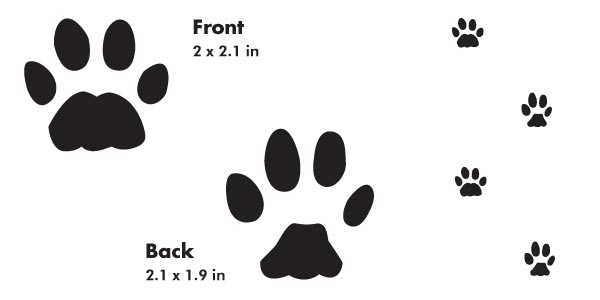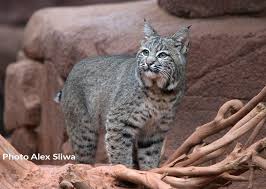

Front slightly larger than back and no claw mark as they are retracted when walking.

Living with Bobcats
Bobcats are common throughout Arizona at all elevations, especially in rimrock and chaparral areas, and in the outskirts of urban areas where food is readily available. Bobcats are generally seen alone, but groups may consist of mating pairs, siblings, or mothers with kittens. Bobcats are most active around sunset and sunrise, and it is not uncommon to find one napping under a shrub in a brushy backyard. Individual bobcats will defend a territory of one to 12 square miles.
Description and Habits
- Tan with dark spots on coat
- Short tail with black tip on top side
- 15-35 pounds (males are larger than females)
- 18-24 inches tall
- 24-48 inches long
- Mate February to March
- Average litter of two to three kittens, usually born from April to early June
- Kittens stay with the mother seven to 12 months
- Live 10-15 years
- Able to jump as high as 12 feet
- Carnivorous, generally feed on small mammals and birds (includes domestic birds and rabbits); will also eat lizards, snakes, and small pets, including house cats
Possible Conflicts with Humans and Pets
If you see a bobcat near your home, there is no need to panic. Bobcats rarely attack people. However, if a bobcat does attack a human, it generally will have symptoms of rabies. Bobcats may be attracted to a yard that has abundant wildlife, domestic birds, small pets, water, and shade or other shelter. Small pets need to be protected from bobcats and other predators. Keep small pets indoors, in an enclosed area with a roof, or on a leash when outside. Domestic birds should be kept in an enclosed area with a sturdy roof (a 6-foot tall fence is not necessarily good protection), and do not spread seed that attracts other wildlife. Do not feed bobcats, as this can encourage them to become too comfortable around humans.
What Attracts Them?
Bobcats may visit an area to find food, water, shelter, or the space they need to live.
- Food may include birds, rodents, rabbits, small unattended pets, poultry or other domestic birds, and other small livestock.
- Water in pools, birdbaths, fountains, and pets’ water dishes can attract bobcats. They will sometimes defecate in shallow water (such as pools and fountains).
- Shelter for bobcats can include rooftops, attics, and the space underneath decks. Other small spaces can make attractive dens also, and bobcats will sometimes rest during the day or bask in the sun. This makes them attracted to thick brush, shade, and unoccupied yards.
What Should I Do?
You may choose to watch and enjoy a bobcat or bobcat family sharing your yard. However, if you have small pets or livestock, you may want to discourage the bobcat from coming onto your property. Remember, your neighbor may think differently, and it is always a good idea to keep wildlife wild.
To discourage a bobcat, immediately:
- Scare off with loud noises or spray with a garden hose.
- If the animal is confined, open a gate, have all people leave the area, and allow it to leave on its own. If it is still confined the following day, or trapped inside a residence, contact a wildlife control business or the Arizona Game and Fish Department.
- Check for kittens in the area, and if kittens are there, then consider tolerating them for a few weeks until the kittens are large enough to leave the area with their mother.
In an emergency: In the rare occasion that a bobcat bites a person or appears hyperactive, there may be some health concerns. Take the following actions:
- Contact your county animal control office.
- Fight back if it has attacked.
- Avoid the area and stay indoors.
- Call your local Arizona Game and Fish Department office (8-5, Monday -Friday excluding holidays). Also, call Arizona Game and Fish if severe property damage has occurred, or if there is possession of a live bobcat. After hours and weekends, a radio dispatcher is available at (623) 236-7201.
Remember, removal is usually a last resort:
Bobcats tend to be abundant where food is plentiful, and different bobcats will keep visiting the same area if attractants aren’t removed. Homeowners may trap and relocate the animal, but should contact the Arizona Game and Fish Department for an appropriate release location before transporting the animal. For a fee, wildlife control businesses will remove animals from the property.
To prevent further problems:
Possible Health Concerns
Rabies – Symptoms of rabies can include foaming at the mouth, erratic, hyperactive behavior, and/or fearful, paralyzed and lethargic behavior. Bobcats rarely get rabies. If you see any animal with symptoms of rabies, stay away from it and call 911, your closest Arizona Game and Fish Department office, or a wildlife control business immediately.
- Keep domestic animals (dogs, cats, chickens, rabbits, rodents, etc.) in a secured enclosure with a sturdy roof.
- Feed your pets inside, or remove uneaten pet food between feedings.
- Close or patch openings in fences.
- Keep shrubbery, grass, etc. trimmed to deny bobcats hiding cover.
- Deny access to bobcats by putting up fencing. However, since bobcats can jump up to 12 feet, a 6-foot fence may not deter them if they are attracted to something in the yard.
- Work with your neighbors to achieve a consistent solution to the situation.
- Look for products that can be used as helpful animal deterrents.
Anyone bitten by a bobcat must immediately seek medical attention from a qualified health care provider. Whenever possible, the animal should be captured or killed and sent to a laboratory for rabies testing.
Laws and Policies
- Bobcats are not considered a threat to human safety except in rare cases when they have rabies or are extremely aggressive. The Arizona Game and Fish Department does not routinely relocate bobcats.
- Bobcats are classified as predatory and furbearing animals. A valid hunting license is required, except in the case of depredation (killing of livestock) removal.
- The possession of live bobcats is illegal.
- State law prohibits firing a gun within a quarter-mile of an occupied residence or building without the permission of the owner.
- Check your local city ordinances, but most cities ban shooting firearms within city limits. Some cities ban the use of slingshots, BB guns, air guns, or bows.
Refer to ARS-17-239 on wildlife depredation and Arizona Game and Fish Department Hunting Regulations for more information
